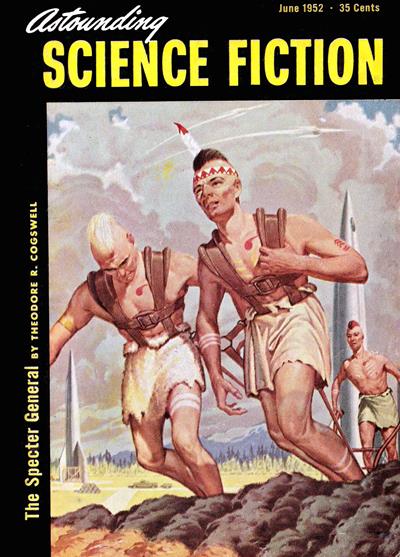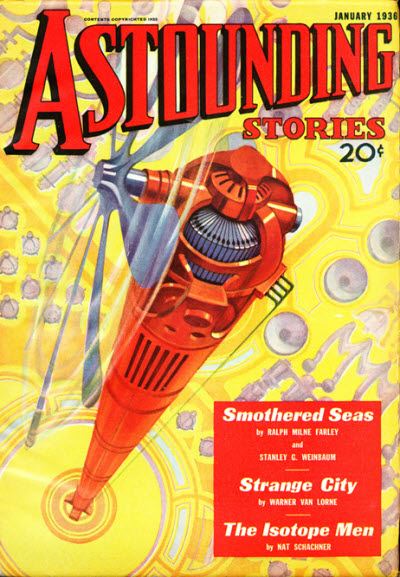
Part of Series
Vol 50, No 3. Contents: 6 • Nonlinear Phenomenon • [Editorial (Astounding)] • essay by John W. Campbell, Jr. [as by The Editor] 8 • Last Blast • novelette by Eric Frank Russell 51 • Pax Galactica • novelette by Ralph Williams 73 • The Analytical Laboratory: August 1952 (Astounding, November 1952) • [The Analytical Laboratory] • essay by The Editor 74 • The Things to Come • short story by Gene L. Henderson 82 • Oil for Tomorrow • essay by Wallace West 94 • In Times to Come (Astounding, November 1952) • [In Times to Come (Astounding)] • essay by The Editor 95 • The High Purpose • short story by Algis Budrys 101 • The Currents of Space (Part 2 of 3) • [Trantorian Empire • 3] • serial by Isaac Asimov 152 • The Reference Library: Junior Division (Astounding, November 1952) • [The Reference Library] • essay by P. Schuyler Miller 159 • Brass Tacks & Letters.
Authors

Isaac Asimov was a Russian-born, American author, a professor of biochemistry, and a highly successful writer, best known for his works of science fiction and for his popular science books. Professor Asimov is generally considered one of the most prolific writers of all time, having written or edited more than 500 books and an estimated 90,000 letters and postcards. He has works published in nine of the ten major categories of the Dewey Decimal System (lacking only an entry in the 100s category of Philosophy). Asimov is widely considered a master of the science-fiction genre and, along with Robert A. Heinlein and Arthur C. Clarke, was considered one of the "Big Three" science-fiction writers during his lifetime. Asimov's most famous work is the Foundation Series; his other major series are the Galactic Empire series and the Robot series, both of which he later tied into the same fictional universe as the Foundation Series to create a unified "future history" for his stories much like those pioneered by Robert A. Heinlein and previously produced by Cordwainer Smith and Poul Anderson. He penned numerous short stories, among them "Nightfall", which in 1964 was voted by the Science Fiction Writers of America the best short science fiction story of all time, a title many still honor. He also wrote mysteries and fantasy, as well as a great amount of nonfiction. Asimov wrote the Lucky Starr series of juvenile science-fiction novels using the pen name Paul French. Most of Asimov's popularized science books explain scientific concepts in a historical way, going as far back as possible to a time when the science in question was at its simplest stage. He often provides nationalities, birth dates, and death dates for the scientists he mentions, as well as etymologies and pronunciation guides for technical terms. Examples include his Guide to Science, the three volume set Understanding Physics, and Asimov's Chronology of Science and Discovery. Asimov was a long-time member and Vice President of Mensa International, albeit reluctantly; he described some members of that organization as "brain-proud and aggressive about their IQs" He took more joy in being president of the American Humanist Association. The asteroid 5020 Asimov, the magazine Asimov's Science Fiction, a Brooklyn, NY elementary school, and two different Isaac Asimov Awards are named in his honor.

Algis Budrys was a Lithuanian-American science fiction author, editor, and critic. He was also known under the pen names Frank Mason, Alger Rome, John A. Sentry, William Scarff, Paul Janvier, and Sam & Janet Argo. Called "AJ" by friends, Budrys was born Algirdas Jonas Budrys in Königsberg in East Prussia. He was the son of the consul general of the Lithuanian government, (the pre-World War II government still recognized after the war by the United States, even though the Soviet-sponsored government was in power throughout most of Budrys' life). His family was sent to the United States by the Lithuanian government in 1936 when Budrys was 5 years old. During most of his adult life, he held a captain's commission in the Free Lithuanian Army. Budrys was educated at the University of Miami, and later at Columbia University in New York. His first published science fiction story was The High Purpose, which appeared in Astounding Science Fiction in 1952. Beginning in 1952 Budrys worked as editor and manager for such science fiction publishers as Gnome Press and Galaxy Science Fiction. Some of his science fiction in the 1950s was published under the pen name "John A. Sentry", a reconfigured Anglification of his Lithuanian name. Among his other pseudonyms in the SF magazines of the 1950s and elsewhere, several revived as bylines for vignettes in his magazine Tomorrow Speculative Fiction, is "William Scarff". He also wrote several stories under the names "Ivan Janvier" or "Paul Janvier." He also used the pen name "Alger Rome" in his collaborations with Jerome Bixby. Budrys' 1960 novella Rogue Moon was nominated for a Hugo Award, and was later anthologized in The Science Fiction Hall of Fame, Volume Two (1973). His Cold War science fiction novel Who? was adapted for the screen in 1973. In addition to numerous Hugo Award and Nebula Award nominations, Budrys won the Science Fiction Research Association's 2007 Pilgrim Award for lifetime contributions to speculative fiction scholarship. In 2009, he was the recipient of one of the first three Solstice Awards presented by the SFWA in recognition of his contributions to the field of science fiction. Budrys was married to Edna Duna; they had four sons. He last resided in Evanston, Illinois. He died at home, from metastatic malignant melanoma on June 9, 2008.



